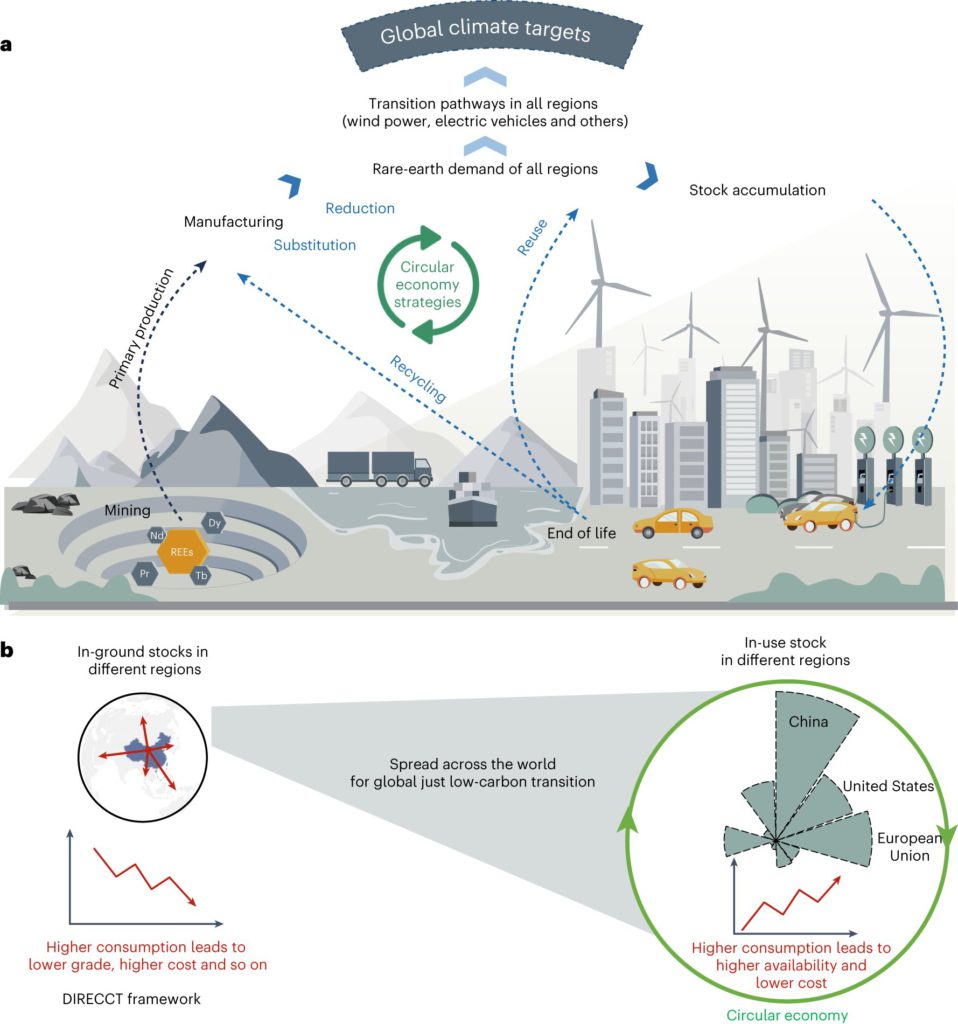Staff Writer | January 5, 2024 |

(Reference image by Thierry Ehrmann, Flickr.)
An international team of researchers has presented a novel integrated model that quantifies how circular economy strategies can reshape global supply chains of critical rare earth elements, such as neodymium, dysprosium and terbium.

The analysis was published in the journal Nature Geoscience and it shows that circular economy strategies can lead to an increase of 701 kt secondary supply and a decrease of 2,306 kt demand within the next three decades.
By looking at the specific impacts of circular economy strategies on the global REE supply and demand landscape, the group found a significant mismatch between in-ground stocks, supply and demand at specific region and element levels, with the mismatch in the supply of heavy rare earth elements being a key obstacle to achieving net-zero emission targets.

This framework aims to map the REE flows from in-ground to in-use stocks for global just transition. a, The roles of different circular economy strategies in the shift of in-ground minerals to in-use stocks. b, How the transition of REEs can assist the clean and just transition along with its spread from mining sites to final consumers across the world. (Image from Nature Geoscience).
The study highlights that substitution, reuse, and recycling will reshape the global REE supply chains. In detail, the implementation of these strategies will lead to an increase in REE supply from urban mines within the next three decades, which can significantly reduce the dependency on mining REE. Some regions like the EU might also achieve a closed-loop REE supply with the implementation of circular economy strategies.
“Our model considers both in-ground stocks and in-use stocks, as well as their quite dramatic geographic shift across ten regions from 2001 to 2050 under three widely accepted climate scenarios,” Oliver Heidrich, co-author of the study and a professor at Newcastle University, said in a media statement. “Our study does shed important light on the demands and supplies and provides a good understanding of the geopolitical dynamics, climate goals and how the natural resources could be used for political gains.”
In Heidrich’s view, the findings can serve as the scientific basis for international cooperation in promoting the circular economy strategies of REE for global and just low-carbon transitions.
At present, the natural reserves of rare earth elements are located in a limited number of countries (China, Vietnam, Brazil, the US, Russia and the Democratic Republic of the Congo); China controls over 90% of the global supply and close to 40% of reserves. Their availability is therefore subject to fluctuations in supply and prices caused by opposing geopolitical interests, with the consequent danger of conflicts.
The study highlights that substitution, reuse, and recycling will reshape the global REE supply chains. In detail, the implementation of these strategies will lead to an increase in REE supply from urban mines within the next three decades, which can significantly reduce the dependency on mining REE. Some regions like the EU might also achieve a closed-loop REE supply with the implementation of circular economy strategies.
“Our model considers both in-ground stocks and in-use stocks, as well as their quite dramatic geographic shift across ten regions from 2001 to 2050 under three widely accepted climate scenarios,” Oliver Heidrich, co-author of the study and a professor at Newcastle University, said in a media statement. “Our study does shed important light on the demands and supplies and provides a good understanding of the geopolitical dynamics, climate goals and how the natural resources could be used for political gains.”
In Heidrich’s view, the findings can serve as the scientific basis for international cooperation in promoting the circular economy strategies of REE for global and just low-carbon transitions.
At present, the natural reserves of rare earth elements are located in a limited number of countries (China, Vietnam, Brazil, the US, Russia and the Democratic Republic of the Congo); China controls over 90% of the global supply and close to 40% of reserves. Their availability is therefore subject to fluctuations in supply and prices caused by opposing geopolitical interests, with the consequent danger of conflicts.
No comments:
Post a Comment